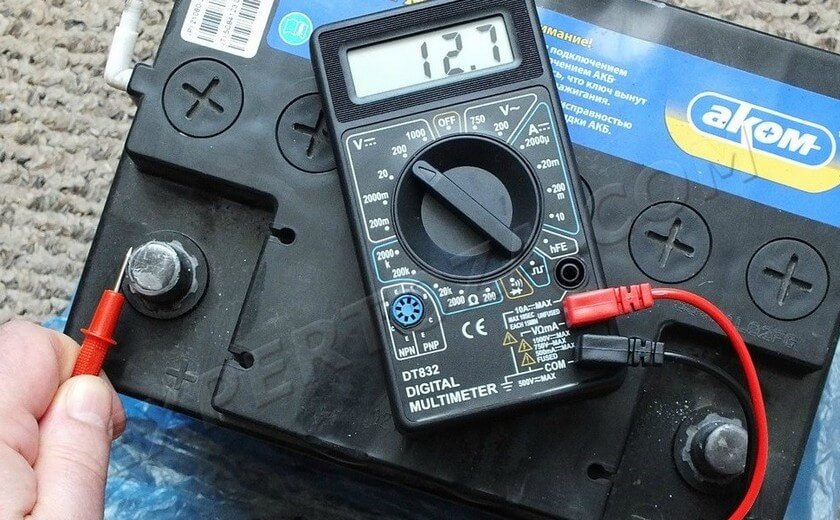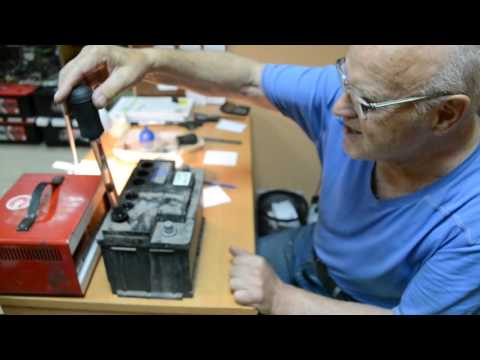
How to check the car battery
Content
- How to check the battery with your own hands
- How to visually check the battery
- How to check the electrolyte level in the battery
- How to check the electrolyte density of a battery
- How to check a car battery with a multimeter
- Load fork test
- How to test a new battery?
- How to check if the battery is alive on a car without instruments?
- How to take care of the battery
Question "how to check car battery”appears, usually, in two cases: when buying a new battery or if some kind of breakdown of the battery is already under the hood. The cause of the breakdown can be either undercharging or overcharging the battery.
Undercharging is due to sulfation of the battery plates, which appears with frequent trips over short distances, a faulty generator voltage regulator relay, and turning on the warm-up.
Overcharging also appears due to a breakdown of the voltage regulator, only in this case it supplies an overvoltage from the generator. As a result, the plates crumble, and if the battery is of a maintenance-free type, then it may also undergo mechanical deformation.
How to check the battery with your own hands
So, how to check the health of the car battery?

Battery diagnostics - checking voltage, level and density.
Of all these methods, the most accessible to the average layman is only to check the car battery with a tester and visually inspect it, well, except to look inside (if the battery is serviced) in order to see the color and electrolyte level. And in order to fully check the car battery for performance at home, you also need a densimeter and a load plug. Only in this way the picture of the state of the battery will be as clear as possible.
Therefore, if there are no such devices, then the minimum actions that are available to everyone are to use a multimeter, a ruler and use regular consumers.
How to check the battery with your own hands
in order to check the battery without special equipment, you need to know its power (say, 60 Ampere / hour) and load it with consumers by half. For example, by connecting several light bulbs in parallel. If after 5 minutes of operation they began to burn dimly, then the battery is not working as it should.
As you can see, such a home check is too primitive, so you can’t do without instructions on how to find out the real state of the machine battery. We will have to consider in detail the principles and all available methods of verification, up to measuring the density of the electrolyte and testing the load with imitation of the starter.
How to visually check the battery
Inspect the battery case for cracks in the case and electrolyte leaks. Cracks can occur in winter if the battery is loose and has a fragile plastic case. Moisture, dirt, fumes or electrolyte streaks collect during operation on the battery, which, together with oxidized terminals, contributes to self-discharge. You can check if you connect one voltmeter probe to "+", and draw the second one along the surface of the battery. The device will show what self-discharge voltage is on a particular battery.
How to check the electrolyte level in the battery
The electrolyte level is checked only on those batteries that are serviceable. To check it, you need to lower the glass tube (with markings) into the battery filler hole. Having reached the separator mesh, you need to pinch the upper edge of the tube with your finger and pull it out. The electrolyte level in the tube will be equal to the level in the battery. Normal level 10-12mm above the battery plates.
How to check the electrolyte density of a battery
To measure the electrolyte density level, you will need a machine hydrometer. It must be lowered into the filler hole of the battery and, using a pear, collect such an amount of electrolyte so that the float dangles freely. Then look at the level on the hydrometer scale.
A feature of this measurement is that the density of the electrolyte in the battery in winter and summer in some regions will be different depending on the season and the average daily temperature outside. The table contains data that should be guided.
| Season | Average monthly air temperature in January (depending on the climatic region) | Fully charged battery | The battery is discharged | |
|---|---|---|---|---|
| on 25% | on 50% | |||
| -50°С…-30°С | Winter | 1,30 | 1,26 | 1,22 |
| Summer | 1,28 | 1,24 | 1,20 | |
| -30°С…-15°С | All year round | 1,28 | 1,24 | 1,20 |
| -15 ° С ... + 8 ° С | All year round | 1,28 | 1,24 | 1,20 |
| 0°С…+4°С | All year round | 1,23 | 1,19 | 1,15 |
| -15 ° С ... + 4 ° С | All year round | 1,23 | 1,19 | 1,15 |
How to check a car battery with a multimeter
To check the battery with a multimeter, you need to switch the latter to the constant voltage measurement mode and set the range above the maximum voltage value for a charged battery. then you need to connect the black probe to the “minus”, and the red one to the “plus” of the battery and see the readings that the device will give.
Battery voltage should not be below 12 volts. If the voltage is lower, then the battery is more than half discharged and needs to be charged.
Checking the battery with the engine running
It is necessary to check the battery with the internal combustion engine running by turning off all energy-consuming devices - the stove, air conditioning, car radio, headlights, etc. The check is performed as standard, as described above.
The designation of the multimeter readings with a working battery is presented in the table below.
| Tester display, Volt | What does this mean? |
|---|---|
| <13.4 | Low voltage, battery not fully charged |
| 13.5 - 14.2 | Normal performance |
| > 14.2 | Increased voltage. usually indicates that the battery is low |
undervoltage indicates a low battery. This is usually caused by a non-working / poorly functioning alternator or oxidized contacts.
Voltage above normal most likely indicates a discharged battery (this often happens during long periods of idle transport, or during winter periods). usually, 10-15 minutes after recharging, the voltage returns to normal. If not, the problem is in the electrical equipment of the car, which threatens to boil the electrolyte.
How to check the battery is charged or not when the internal combustion engine is not running?
When checking the battery with the internal combustion engine turned off, checking with a multimeter is carried out in the same way as described above. All consumers must be disabled.
Indications are indicated in the table.
| Tester display, Volt | What does this mean? |
|---|---|
| 11.7 | The battery is almost completely discharged |
| 12.1 – 12.4 | Battery is about half charged |
| 12.5 – 13.2 | Battery fully charged |
Load fork test
Load fork - a device that is a kind of electrical load (usually a high-resistance resistor or a refractory coil) with two wires and terminals for connecting the device to the battery, as well as a voltmeter for taking voltage readings.
The verification process is quite simple. It consists of the following steps:
- It is necessary to work at a temperature of + 20 ° С ... + 25 ° С (in extreme cases up to + 15 ° С). Can't test a cold battery, since you run the risk of significantly discharging it.
- The plug is connected to the battery terminals - the red wire to the positive terminal, and the black wire to the negative terminal.
- Using the device, a load is created with a current strength of 100 ... 200 Amperes (this imitation of the included starter).
- The load acts on the battery for 5 ... 6 seconds.
According to the results of the readings of the ammeter and voltmeter, we can talk about the condition of the battery.
| Voltmeter readings, V | Charge percentage, % |
|---|---|
| > 10,2 | 100 |
| 9,6 | 75 |
| 9 | 50 |
| 8,4 | 25 |
| <7,8 | 0 |
On a fully charged battery after applying the load, the voltage should not fall below 10,2 V. If the battery is slightly discharged, then a drawdown of up to 9 V is allowed (however, in this case it must be charged). And after that voltage should be restored almost immediately the same, and after a few seconds completely.
Sometimes it happens that if the voltage is not restored, then it is likely that one of the cans will close. For example, at minimum load, it is necessary for the voltage to recover to 12,4 V (up to 12 V is allowed with a slightly discharged battery). Accordingly, the lower the voltage drops from 10,2 V, the worse the battery is. With such a device, you can check the battery both upon purchase and already installed on the car, and without removing it.
How to test a new battery?
Checking a car battery before buying is a very important procedure. Firstly, when using a low-quality battery, defects often appear only after a certain time, which makes it impossible to replace the battery under warranty. Secondly, even with the timely detection of counterfeit, the warranty replacement procedure can be quite lengthy (checking and evaluating the goods by specialists, etc.).
Therefore, in order to avoid problems, before buying, you can use a simple verification algorithm that will save 99% from purchasing low-quality batteries:
- Visual inspection. You also need to look at the production date. If the battery is more than 2 years old, it is better not to buy it.
- Measuring the voltage at the terminals with a multimeter. The voltage on the new battery must be at least 12.6 volts.
- Checking the battery with a load plug. Sometimes the sellers themselves offer to perform this procedure, if not, then it is advisable to demand that you check the performance of the machine battery with a load plug yourself.
How to check if the battery is alive on a car without instruments?
Battery indicator
It is quite easy to determine the condition of the battery on a car without special instruments. This can be done in several ways.
Modern batteries have a special charge indicator, usually in the form of a round window. You can determine the charge by the color of this indicator. Next to such an indicator on the battery there is always a decoding indicating which color corresponds to a particular charge level. Green - the charge is full; gray - half charge; red or black - full discharge.
In the absence of such an indicator, two methods can be used. The first is with headlights. The cooled ICE is started, and the dipped beam is turned on. If the light does not dim after 5 minutes of operation, then everything is normal.
The second (also cold) is to turn on the ignition, wait a minute, and then press the signal several times. With a “live” battery, the beep sound will be loud and continuous.
How to take care of the battery
In order for the battery to last longer and not fail prematurely, it should be regularly looked after. For this battery and its terminals must be kept clean, and with a long idle discharge / charge. In severe frosts, it is better to take the battery from under the hood to a warmer place. Some manufacturers recommend charging the battery once every 1-2 weeks, arguing that sometimes the consumption exceeds the self-charging of the battery. So, checking the battery is a task that is quite feasible and necessary for the proper operation of the car.

